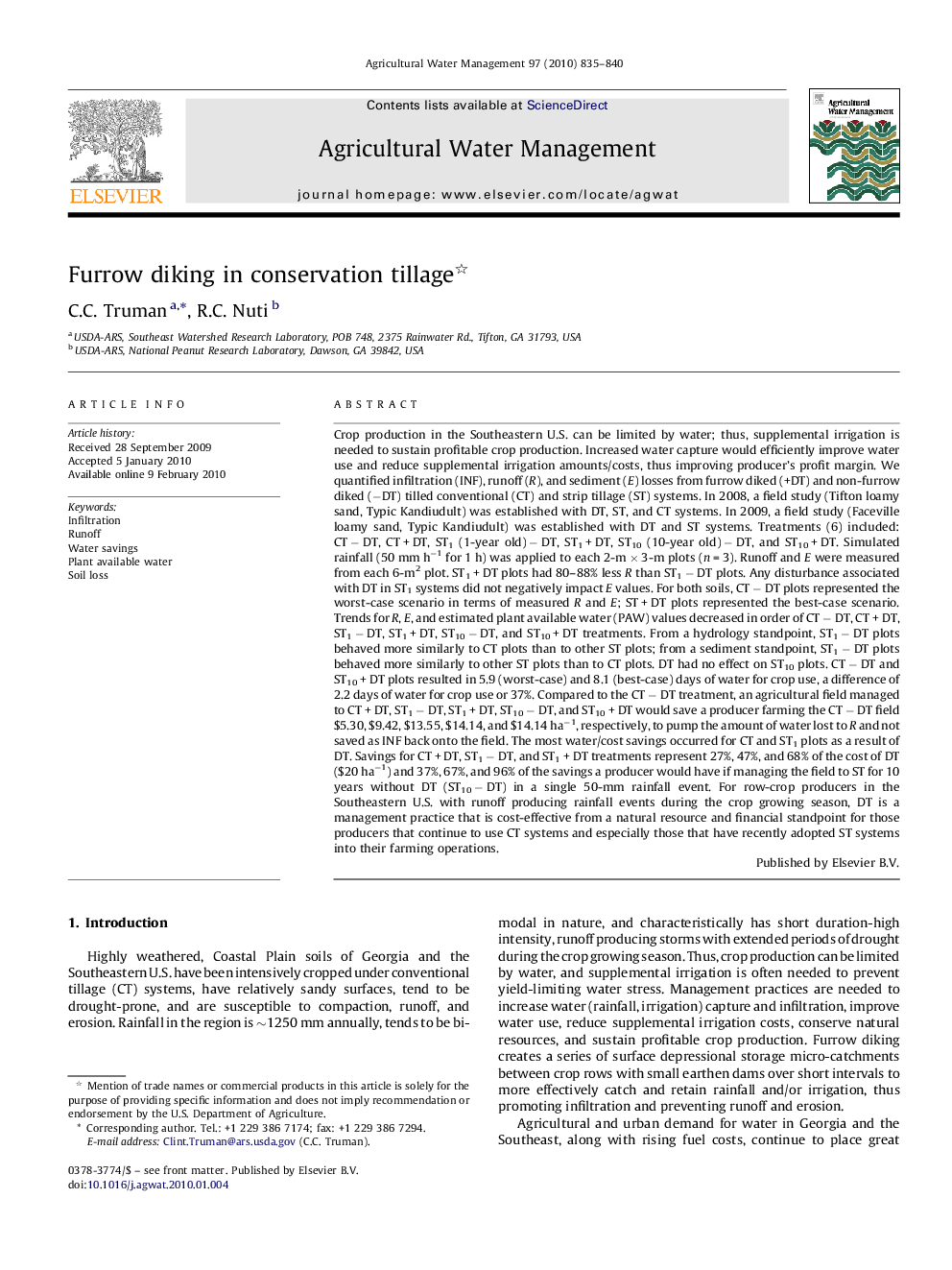| کد مقاله | کد نشریه | سال انتشار | مقاله انگلیسی | نسخه تمام متن |
|---|---|---|---|---|
| 4479892 | 1316463 | 2010 | 6 صفحه PDF | دانلود رایگان |

Crop production in the Southeastern U.S. can be limited by water; thus, supplemental irrigation is needed to sustain profitable crop production. Increased water capture would efficiently improve water use and reduce supplemental irrigation amounts/costs, thus improving producer's profit margin. We quantified infiltration (INF), runoff (R), and sediment (E) losses from furrow diked (+DT) and non-furrow diked (−DT) tilled conventional (CT) and strip tillage (ST) systems. In 2008, a field study (Tifton loamy sand, Typic Kandiudult) was established with DT, ST, and CT systems. In 2009, a field study (Faceville loamy sand, Typic Kandiudult) was established with DT and ST systems. Treatments (6) included: CT − DT, CT + DT, ST1 (1-year old) − DT, ST1 + DT, ST10 (10-year old) − DT, and ST10 + DT. Simulated rainfall (50 mm h−1 for 1 h) was applied to each 2-m × 3-m plots (n = 3). Runoff and E were measured from each 6-m2 plot. ST1 + DT plots had 80–88% less R than ST1 − DT plots. Any disturbance associated with DT in ST1 systems did not negatively impact E values. For both soils, CT − DT plots represented the worst-case scenario in terms of measured R and E; ST + DT plots represented the best-case scenario. Trends for R, E, and estimated plant available water (PAW) values decreased in order of CT − DT, CT + DT, ST1 − DT, ST1 + DT, ST10 − DT, and ST10 + DT treatments. From a hydrology standpoint, ST1 − DT plots behaved more similarly to CT plots than to other ST plots; from a sediment standpoint, ST1 − DT plots behaved more similarly to other ST plots than to CT plots. DT had no effect on ST10 plots. CT − DT and ST10 + DT plots resulted in 5.9 (worst-case) and 8.1 (best-case) days of water for crop use, a difference of 2.2 days of water for crop use or 37%. Compared to the CT − DT treatment, an agricultural field managed to CT + DT, ST1 − DT, ST1 + DT, ST10 − DT, and ST10 + DT would save a producer farming the CT − DT field $5.30, $9.42, $13.55, $14.14, and $14.14 ha−1, respectively, to pump the amount of water lost to R and not saved as INF back onto the field. The most water/cost savings occurred for CT and ST1 plots as a result of DT. Savings for CT + DT, ST1 − DT, and ST1 + DT treatments represent 27%, 47%, and 68% of the cost of DT ($20 ha−1) and 37%, 67%, and 96% of the savings a producer would have if managing the field to ST for 10 years without DT (ST10 − DT) in a single 50-mm rainfall event. For row-crop producers in the Southeastern U.S. with runoff producing rainfall events during the crop growing season, DT is a management practice that is cost-effective from a natural resource and financial standpoint for those producers that continue to use CT systems and especially those that have recently adopted ST systems into their farming operations.
Journal: Agricultural Water Management - Volume 97, Issue 6, June 2010, Pages 835–840